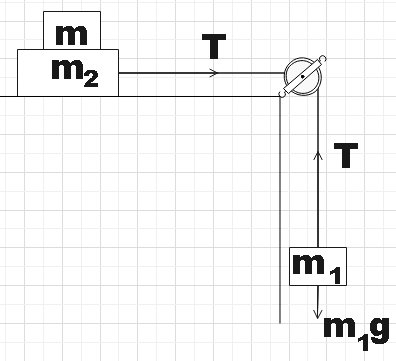
Two masses ${{m}_{1}}=5kg$ and ${{m}_{2}}=10kg$ connected by an inextensible string over a frictionless pulley are moving as shown in the figure. The coefficient of friction of the horizontal surface is 0.15. The minimum weight m that should be put on top of ${{m}_{2}}$ to stop the motion is:

A. 43.3kg
B. 10.3kg
C. 18.3kg
D. 23.3kg

Answer
543.3k+ views
Hint: You could make free body diagrams for both the blocks including m. Now, find the condition at which the system shows the probability of no motion. Equating the forces on either side will help to do that. Then you could substitute the given values and hence get the required answer.
Formula used:
Frictional force,
${{F}_{f}}=\mu N$
Complete answer:
In the question, we are given a spring mass system. We asked to find the minimum weight m that has to be placed on ${{m}_{2}}$ so as to stop the motion in the given system. For that, let us make the free body diagram of the two masses.
For ${{m}_{1}}$,

$T={{m}_{1}}g$ ……………………………………… (1)
Now for$m+{{m}_{2}}$,
$N=\left( m+{{m}_{2}} \right)g$
${{F}_{f}}=\mu N$
$\Rightarrow {{F}_{f}}=\mu \left( m+{{m}_{2}} \right)g$
When there is no motion in the system we could say that the frictional force balances the Tension in the string, that is,
${{F}_{f}}\ge T$
$\Rightarrow T\le \mu \left( m+{{m}_{2}} \right)g$
From (1),
$\mu \left( m+{{m}_{2}} \right)g\ge {{m}_{1}}g$
Substituting the given values, we will get,
$0.15\left( m+10 \right)\ge 5$
$\Rightarrow 0.15m+1.5\ge 5$
$\therefore m\ge 23.3kg$
Therefore, we found that if the mass m is having value that is equal to greater than 23.3kg, then the system will be at rest. Hence, the minimum mass should be 23.3kg
So,option D is found to be the correct answer.
Note:
You may be wondering why we have used the inequality sign instead of the equality sign. This is because the frictional force is known to resist the relative motion (here, between the blocks and the surface). In such a condition, the greater the frictional force is the easier it will be to maintain the system at rest.
Formula used:
Frictional force,
${{F}_{f}}=\mu N$
Complete answer:
In the question, we are given a spring mass system. We asked to find the minimum weight m that has to be placed on ${{m}_{2}}$ so as to stop the motion in the given system. For that, let us make the free body diagram of the two masses.
For ${{m}_{1}}$,

$T={{m}_{1}}g$ ……………………………………… (1)
Now for$m+{{m}_{2}}$,
$N=\left( m+{{m}_{2}} \right)g$
${{F}_{f}}=\mu N$
$\Rightarrow {{F}_{f}}=\mu \left( m+{{m}_{2}} \right)g$
When there is no motion in the system we could say that the frictional force balances the Tension in the string, that is,
${{F}_{f}}\ge T$
$\Rightarrow T\le \mu \left( m+{{m}_{2}} \right)g$
From (1),
$\mu \left( m+{{m}_{2}} \right)g\ge {{m}_{1}}g$
Substituting the given values, we will get,
$0.15\left( m+10 \right)\ge 5$
$\Rightarrow 0.15m+1.5\ge 5$
$\therefore m\ge 23.3kg$
Therefore, we found that if the mass m is having value that is equal to greater than 23.3kg, then the system will be at rest. Hence, the minimum mass should be 23.3kg
So,option D is found to be the correct answer.
Note:
You may be wondering why we have used the inequality sign instead of the equality sign. This is because the frictional force is known to resist the relative motion (here, between the blocks and the surface). In such a condition, the greater the frictional force is the easier it will be to maintain the system at rest.
Recently Updated Pages
Why are manures considered better than fertilizers class 11 biology CBSE

Find the coordinates of the midpoint of the line segment class 11 maths CBSE

Distinguish between static friction limiting friction class 11 physics CBSE

The Chairman of the constituent Assembly was A Jawaharlal class 11 social science CBSE

The first National Commission on Labour NCL submitted class 11 social science CBSE

Number of all subshell of n + l 7 is A 4 B 5 C 6 D class 11 chemistry CBSE

Trending doubts
Differentiate between an exothermic and an endothermic class 11 chemistry CBSE

10 examples of friction in our daily life

One Metric ton is equal to kg A 10000 B 1000 C 100 class 11 physics CBSE

Difference Between Prokaryotic Cells and Eukaryotic Cells

State the laws of reflection of light

Explain zero factorial class 11 maths CBSE




